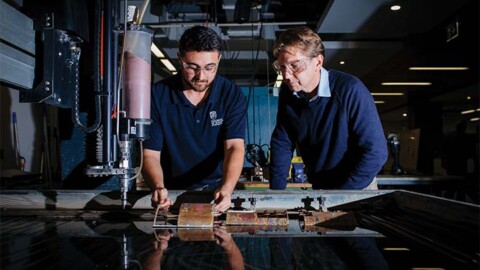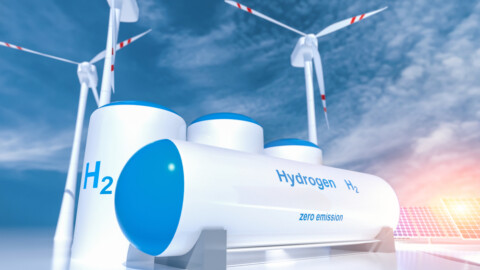by Michelle Goldsmith, Contributing Editor, Energy Magazine
Across Australia and the world, interest in big batteries is surging. In particular, large-scale grid-connected battery systems are expected to play an important role in Australia’s energy future, with a growing number of large storage projects planned or underway. Integrated into the National Electricity Market (NEM), these big batteries will help stabilise networks and pave the way for increased renewable energy generation. As Australia enters the era of the big battery, we take a look at the story so far, detailing some of the largest battery storage systems already operating or under construction.
Australia’s energy networks are evolving, and lithium-ion battery storage is coming to the fore. The costs associated with grid-scale battery storage technologies have significantly decreased over the last decade, while battery storage capabilities continue to grow rapidly, resulting in a much improved economic case for large-scale battery projects.
As a result, governments and private companies are investing in an ever-increasing number of big batteries to expand network storage capabilities.
Enabling Australia’s energy future
Large-scale energy storage, and battery storage in particular, offers a range of important benefits to electricity grids, especially when higher levels of intermittent renewable energy generation exist.
Battery energy storage systems (BESS) help stabilise the grid against frequency disruptions and provide a source of energy to be drawn on in peak periods of demand, or during periods where intermittent renewable energy sources, such as solar or wind farms, aren’t generating.
As a result, they can help mitigate costs and defer the need for additional generation infrastructure or network upgrades to meet peak demand.
Battery peakers can ramp up quickly, have near-zero start-up time and provide a strong frequency response. As energy networks shift away from fossil fuels to reduce emissions and mitigate climate change, these dispatchable energy resources are a vital enabler to a clean energy future.
A BESS can be used for energy market participation, load shifting, and providing various market and non-market ancillary services to the NEM.
According to AEMO’s 2020 Integrated System Plan, 63 per cent of coal-fired generation is anticipated to retire by 2040, replaced by approximately 26-50GW of wind and solar generation.
These renewables will require up to 19GW of firming generation, such as pumped hydro, battery storage and gas. Several big batteries are already operating in parts of Australia, and many more even larger battery systems are under construction, confirmed, in planning, or proposed.
The state of play: operational big batteries
Hornsdale Power Reserve (150MW/193.5MWh), South Australia
With a capacity of 150MW/194MWh, Hornsdale Power Reserve is currently the largest operational battery in Australia. The battery is owned by Neoen and co-located with the Hornsdale Wind Farm in mid-north South Australia.
When the original $172 million construction project was completed in 2017, it was the largest lithium-ion battery in the world at 100MW/129 MWh. In 2020, an $82 million expansion project was completed, increasing the storage capacity by 50MW/64.5MWh to a total of 150MW/193.5MWh. The installation is based on Tesla battery technology.
Lake Bonney BESS (25MW/52MWh), South Australia
The Lake Bonney Battery Energy Storage System, located with the Lake Bonney Wind Farm near Millicent in South Australia, has a capacity of 25MW/52MWh.
This Tesla-based lithium-ion BESS is owned by Infigen and was energised in 2019. According to ARENA, which co-funded the project, the final construction cost totalled around $41.6 million.
Gannawarra Energy Storage System (25MW/50MWh), Victoria
The Gannawarra Energy Storage System (GESS) is a 25MW/50MWh grid-scale lithium-ion battery located with the Gannawarra Solar Farm in north-western Victoria.
The $41.19 million project was undertaken by Edify in a consortium with Wirsol Energy, using Tesla Powerpack technology, and was completed in 2018. The GESS is operated by EnergyAustralia, under agreement with the joint owners Edify and Wirsol.
Ballarat Energy Storage System (30MW/30MWh), Victoria
The Ballarat Energy Storage System (BESS) has a capacity of 30MW/30MWh and utilises Fluence lithium-ion battery technology. The BESS is a standalone system, located at the AusNet Services Ballarat Terminal Station in Warrenheip, Ballarat. It is owned by AusNet Services, and operated by EnergyAustralia.
The construction project was undertaken by a consortium comprising Downer Spotless, AusNet Services, EnergyAustralia and Fluence, and the BESS was integrated into the Victorian grid in 2018.
Bulgana Green Power Hub Battery Storage (20MW/34MWh), Victoria
This 20MW/34MWh Tesla-based lithium-ion battery is part of the Bulgana Green Power Hub in the Wimmera region of central-western Victoria, along with a 194MW wind farm.
The hub is owned by Neoen, which undertook a $350 million project to construct the battery and wind farm. After delays in commissioning, the battery was switched on in 2021.
Dalrymple BESS (30MW/8MWh), South Australia
The 30MW/8MWh Dalrymple Battery Energy Storage System is located at ElectraNet’s Dalrymple substation on the Yorke Peninsula in South Australia. The $30 million project was completed in 2018 and was the first BESS in the National Electricity Market (NEM) to provide both regulated network reliability and security services alongside competitive market services.
The Dalrymple BESS is owned by ElectraNet and operated by AGL. This standalone BESS uses Samsung lithium-ion battery technology. In 2021, ElectraNet returned the $12 million grant the company received to construct the BESS to the Australian Renewable Energy Agency (ARENA), due to the project’s financial success.
Newman Battery Storage (35MW/11MWh), Western Australia
The Newman BESS operates on an islanded high-voltage grid supplying power to major mining operations in the Pilbara region of WA. It is owned by Alinta Energy and located adjacent to the company’s gas-fired Newman Power Station.
This 35MW/11MWh battery system uses Kokam technology. Its construction cost was around $45 million and it was completed in 2018.
Agnew Gold Mine BESS (13MW/4MWh), Western Australia
The Agnew Gold Mine BESS is another battery system operating on a private grid in Western Australia. The BESS is part of the hybrid gas and renewable energy microgrid powering operations at the remote Agnew Gold Mine. The $111.6 million microgrid project was completed in 2020 and uses Saft lithium-ion batteries.
The next big thing: big battery projects underway
Victorian Big Battery (300MW/450MWh), Victoria
The Victorian Big Battery is being constructed by Neoen in Geelong, Victoria. When completed in late 2021 to early 2022, the 300MW/450MWh BESS is likely to be Australia’s largest battery at the time. Owner Neoen has not disclosed the total anticipated project cost.
However, the Federal-owned Clean Energy Finance Corporation (CEFC) is providing $160 million towards its construction. The Victorian Government will pay $84.8 million over 11 years for the services provided by the BESS, which should alleviate unscheduled load shedding over the peak summer months.
The project experienced a setback in July 2021, when a fire occurred at two of the Tesla Megapack BESS units during testing. Works have since resumed, with the approval of the safety regulator, after measures were put in place to prevent recurrence, and the project is still expected to be completed to schedule.
Wandoan South BESS (100MW/150MWh), Queensland
The 100MW/150MWh Wandoan South Battery Energy Storage System (BESS) is being constructed by Vena Energy in the Darling Downs region of Queensland. The $120 million construction project is nearing completion and, once operational, the BESS will be contracted to AGL.
The BESS uses lithium-ion battery technology, operated by a Doosan control and monitoring system. When connected to Powerlink’s Wandoan South Substation, it will be Queensland’s first state-grid-connected big battery.
Wallgrove Grid Battery/Western Sydney BESS (50MW/75MWh), New South Wales
Construction on Transgrid’s 50MW/75MWh Wallgrove Grid Battery began in early 2021, at the Wallgrove substation in Western Sydney.
When commissioned, the Tesla Megapack lithium-ion battery system will be operated by Infigen, providing synthetic inertia and fast frequency response services to stabilise the grid. The project is expected to cost around $61.9 million in total.
Tom Price Battery (45MW/12MWh), Western Australia
The Tom Price Battery is under construction by Rio Tinto in the Pilbara region of Western Australia. The lithium-ion battery system will have a capacity of 45MW/12MWh and power Rio Tinto’s iron ore mining operations.
When complete, the Tom Price Battery will be the largest battery connected to a private grid (as opposed to an interconnected national grid, such as the Australian NEM) in the world. The system is employing Hitachi ABB inverters and Kokam batteries.
Lincoln Gap BESS (10MW/10MWh), South Australia
The 10MW/10MWh Lincoln Gap BESS is located at the Lincoln Gap Wind Farm in South Australia. The BESS is owned by Nexif Energy and utilises LG Chem lithium-ion battery technology, supplied by Fluence.
The battery was installed as part of the ongoing three-stage $770 million Lincoln Gap Wind Farm project. Construction of the battery is complete, but commissioning has been subject to significant delays, due to a supplier change resulting in regulatory issues.
The second stage of the project is currently underway, and the battery capacity is likely to be expanded in the future.
Wooreen Energy Storage System (350MW/1400MWh), Victoria
Co-located with EnergyAustralia’s Jeeralang gas-fired power station, the Wooreen Energy Storage System will be Australia’s first four-hour utility-scale battery of 350MW capacity. It will provide cover for more than 230,000 Victorian households for four hours before needing to be recharged.
EnergyAustralia is currently seeking partners to help in the delivery of this project, which is scheduled for completion by 2026. In the next edition of Energy, part two of this series will explore Australia’s battery storage future, examining the rapid expansion of projects across the country, and detailing some of the biggest upcoming grid-scale battery projects.
In the next edition of Energy, part two of this series will explore Australia’s battery storage future, examining the rapid expansion of projects across the country, and detailing some of the biggest upcoming grid-scale battery projects.

















